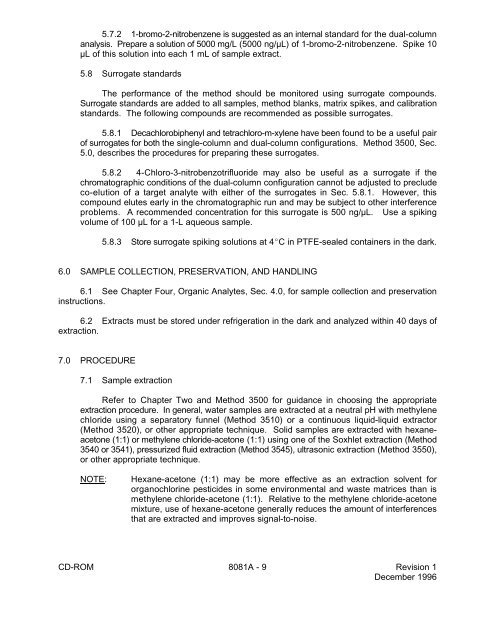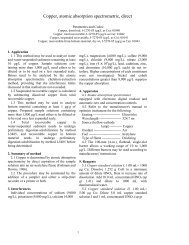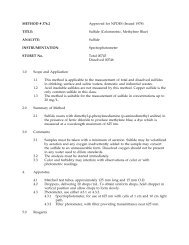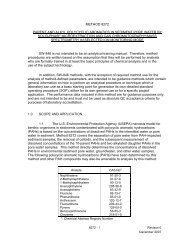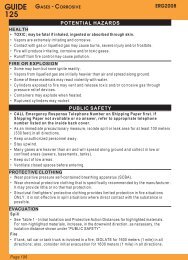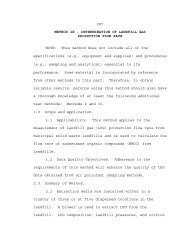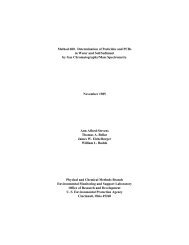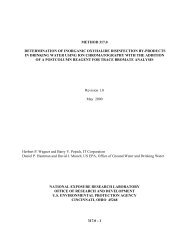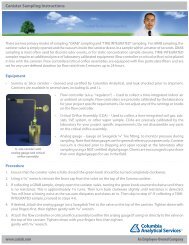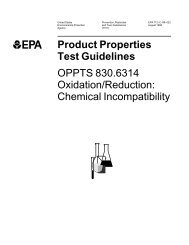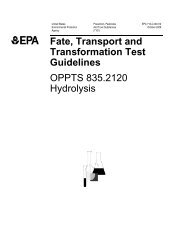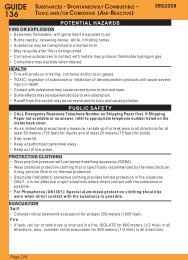View Actual EPA Method 8081A (PDF File)
View Actual EPA Method 8081A (PDF File)
View Actual EPA Method 8081A (PDF File)
You also want an ePaper? Increase the reach of your titles
YUMPU automatically turns print PDFs into web optimized ePapers that Google loves.
5.7.2 1-bromo-2-nitrobenzene is suggested as an internal standard for the dual-columnanalysis. Prepare a solution of 5000 mg/L (5000 ng/µL) of 1-bromo-2-nitrobenzene. Spike 10µL of this solution into each 1 mL of sample extract.5.8 Surrogate standardsThe performance of the method should be monitored using surrogate compounds.Surrogate standards are added to all samples, method blanks, matrix spikes, and calibrationstandards. The following compounds are recommended as possible surrogates.5.8.1 Decachlorobiphenyl and tetrachloro-m-xylene have been found to be a useful pairof surrogates for both the single-column and dual-column configurations. <strong>Method</strong> 3500, Sec.5.0, describes the procedures for preparing these surrogates.5.8.2 4-Chloro-3-nitrobenzotrifluoride may also be useful as a surrogate if thechromatographic conditions of the dual-column configuration cannot be adjusted to precludeco-elution of a target analyte with either of the surrogates in Sec. 5.8.1. However, thiscompound elutes early in the chromatographic run and may be subject to other interferenceproblems. A recommended concentration for this surrogate is 500 ng/µL. Use a spikingvolume of 100 µL for a 1-L aqueous sample.5.8.3 Store surrogate spiking solutions at 4EC in PTFE-sealed containers in the dark.6.0 SAMPLE COLLECTION, PRESERVATION, AND HANDLING6.1 See Chapter Four, Organic Analytes, Sec. 4.0, for sample collection and preservationinstructions.6.2 Extracts must be stored under refrigeration in the dark and analyzed within 40 days ofextraction.7.0 PROCEDURE7.1 Sample extractionRefer to Chapter Two and <strong>Method</strong> 3500 for guidance in choosing the appropriateextraction procedure. In general, water samples are extracted at a neutral pH with methylenechloride using a separatory funnel (<strong>Method</strong> 3510) or a continuous liquid-liquid extractor(<strong>Method</strong> 3520), or other appropriate technique. Solid samples are extracted with hexaneacetone(1:1) or methylene chloride-acetone (1:1) using one of the Soxhlet extraction (<strong>Method</strong>3540 or 3541), pressurized fluid extraction (<strong>Method</strong> 3545), ultrasonic extraction (<strong>Method</strong> 3550),or other appropriate technique.NOTE:Hexane-acetone (1:1) may be more effective as an extraction solvent fororganochlorine pesticides in some environmental and waste matrices than ismethylene chloride-acetone (1:1). Relative to the methylene chloride-acetonemixture, use of hexane-acetone generally reduces the amount of interferencesthat are extracted and improves signal-to-noise.CD-ROM <strong>8081A</strong> - 9 Revision 1December 1996


